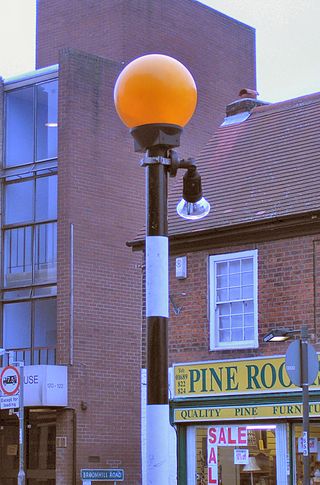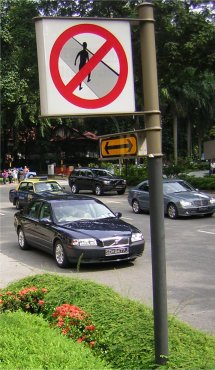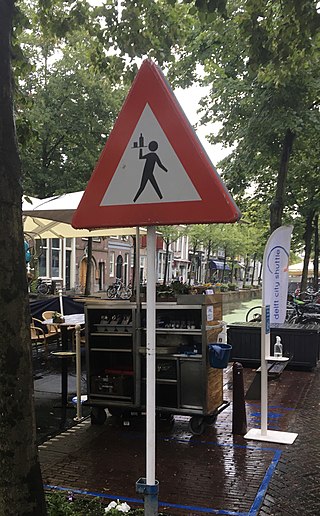
Traffic comprises pedestrians, vehicles, ridden or herded animals, trains, and other conveyances that use public ways (roads) for travel and transportation.

A roundabout, also known as a rotary or traffic circle, is a type of circular intersection or junction in which road traffic is permitted to flow in one direction around a central island, and priority is typically given to traffic already in the junction.

An intersection or an at-grade junction is a junction where two or more roads converge, diverge, meet or cross at the same height, as opposed to an interchange, which uses bridges or tunnels to separate different roads. Major intersections are often delineated by gores and may be classified by road segments, traffic controls and lane design.

A pedestrian crossing is a place designated for pedestrians to cross a road, street or avenue. The term "pedestrian crossing" is also used in the Vienna and Geneva Conventions, both of which pertain to road signs and road traffic.

A pelican crossing is a type of pedestrian crossing with traffic signals for both pedestrians and vehicular traffic, activated by call buttons for pedestrians, with the walk signal being directly across the road from the pedestrian. Pelican crossings are ubiquitous in many countries, but usage of the phrase "pelican crossing" is confined mainly to the UK and Ireland. The design was originally introduced in the United Kingdom; they are also found in the Isle of Man, the Channel Islands, Ireland, Indonesia and Australia. The crossings began to be phased out in Great Britain in 2016, being replaced with puffin crossings which have pedestrian signals above the call button rather than across the road.

A Belisha beacon is an amber-coloured globe lamp atop a tall black and white striped pole, marking pedestrian crossings of roads in the United Kingdom, Ireland, and other countries historically influenced by Britain, such as Hong Kong, Malta, and Singapore. The beacons were named after Leslie Hore-Belisha (1893–1957), the Minister of Transport who, in 1934, added beacons to pedestrian crossings, marked by large metal studs in the road surface. These crossings were later painted in black and white stripes, and thus are known as zebra crossings. Legally, pedestrians have priority on such crossings.

A toucan crossing is the British term for a type of pedestrian crossing that also allows bicycles to be ridden across. Since “two can” cross together the name “toucan” was chosen. In the United Kingdom toucan crossings are normally four metres (13 feet) wide, instead of the 2.8 metre (9 feet) width of any pelican crossing or puffin crossing.

Traffic lights, traffic signals, or stoplights – also known as robots in South Africa – are signalling devices positioned at road intersections, pedestrian crossings, and other locations in order to control the flow of traffic.

A puffin crossing is a type of pedestrian crossing in use in the United Kingdom.
A chicane is a serpentine curve in a road, added by design rather than dictated by geography. Chicanes add extra turns and are used both in motor racing and on roads and streets to slow traffic for safety. For example, one form of chicane is a short, shallow S-shaped turn that requires the driver to turn slightly left and then slightly right to continue on the road, requiring the driver to reduce speed. The word chicane is derived from the French verb chicaner, which means "to create difficulties" or "to dispute pointlessly", "quibble", which is also the root of the English noun chicanery. The Spanish verb chicanear also means "to use trickery".

Jaywalking is the act of pedestrians walking in or crossing a roadway if that act contravenes traffic regulations. The term originated in the United States as a derivation of the phrase jay-drivers, people who drove horse-drawn carriages and automobiles on the wrong side of the road, before taking its current meaning. Jaywalking was coined as the automobile arrived in the street in the context of the conflict between pedestrian and automobiles, more specifically the nascent automobile industry.
The panda crossing was a type of signal-controlled pedestrian crossing used in the United Kingdom from 1962 to 1967.

A junction is where two or more roads meet.

Road signs in Sweden are regulated in Vägmärkesförordningen, VMF (2007:90), and are to be placed 2 metres from the road with the sign 1.6 m from the base for motorized roads. Except for route numbers, there are a maximum of three signs on a pole, with the most important sign at the top. All signs have a reflective layer added on selected parts of the sign as is custom in European countries; most larger signs also have their own illumination.

In traffic engineering, there are regional and national variations in traffic light operation. This may be in the standard traffic light sequence or by the use of special signals.

A HAWK beacon is a traffic control device used to stop road traffic and allow pedestrians to cross safely. It is officially known as a pedestrian hybrid beacon. The purpose of a HAWK beacon is to allow protected pedestrian crossings, stopping vehicular traffic only as needed. The HAWK beacon is a type of traffic control alternative to traffic control signals and/or where an intersection does not meet traffic signal warrants.

The normal function of traffic lights requires more than sight control and coordination to ensure that traffic and pedestrians move as smoothly, and safely as possible. A variety of different control systems are used to accomplish this, ranging from simple clockwork mechanisms to sophisticated computerized control and coordination systems that self-adjust to minimize delay to people using the junction.

The road signs of the Kingdom of the Netherlands, as well as Suriname, are regulated in the Reglement verkeersregels en verkeerstekens 1990, commonly abbreviated as RVV 1990. While most previous signage, from the RVV 1966 (Dutch) remained legal and official, they have been updated / replaced. Some aren't official anymore and have lost legal validity, but most surviving old signs remained valid.

Bosnia and Herzegovina is a signatory to the Vienna Convention on Road Signs and Signals. Therefore, road signs do not differ much from the rest of Europe, such as Croatia, Slovenia, Serbia and North Macedonia. Ministry of Transportation of Bosnia and Herzegovina regulates them. Bosnia and Herzegovina drives on the right as with the rest of Europe, except for Cyprus, Ireland, Malta and the United Kingdom. Bosnian and Herzegovinan road signs have two scripts, Latin and Cyrillic script.

The United Kingdom has specific types of pedestrian crossing.




















